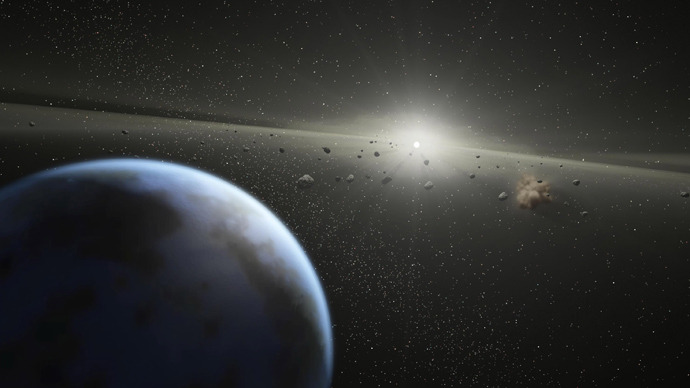Asteroid ‘size of city block’ skims past Earth on Saturday

The 460-foot-long Asteroid 2013 ET has whizzed past Earth on Saturday - the latest in our planet’s galactic ‘pinball contest’. Earlier in the day, the 2013 EC20 passed even closer, and both within a month of the Chelyabinsk meteorite’s strike.
The enormous piece of space debris has passed just 2.5 lunar
distances from planet Earth – the moon is approximately 384,400 km
(238,000 miles) from us, meaning the asteroid’s flyby will be at a
distance of about 950,000km (600,000 miles).
Some astronomers have compared its size to that of a city block,
others a football pitch. Its dimensions were widely given as 460
feet (140m) long and 210 feet (64m) wide. A professional American
football field is 360 feet by 160 feet, which would make this
asteroid 100 feet longer than a football field, and 50 feet wider,
should it live up to calculations.
Celestial bodies: What's the difference?
A meteor is a ‘shooting star’, or the flash of light seen when a small chunk of space debris burns up in the Earth’s atmosphere. However, the word does not refer to the debris itself, which is called a meteoroid.
A meteoroid is the interplanetary matter – a small rock or piece of space debris that burns up in the Earth’s atmosphere and is the source of the meteor.
A meteorite is a meteoroid that survives the falling through the Earth’s atmosphere and subsequently collides with the Earth’s surface.
Asteroids are generally larger chunks of matter from space, and tend to come from the asteroid belt located between the orbits of Mars and Jupiter.
Comets are asteroid-like objects, but have a visible atmosphere called a ‘coma’ which resembles a kind of ‘shell’ and/or ‘tail’, created by ice, ammonia, or other compounds.
Asteroid 2013 ET was first detected on March 3 by the Catalina Sky Survey based at the University of Arizona, and now approaches the planet less than a week after it first hit astronomers’ radars.
It was not bright enough to view through standard personal binoculars or small ‘backyard’ telescopes, but was visible using larger, professional devices in observatories, one of which will broadcast its passage online.
Although it was due to be shown via live webcast by the Virtual Telescope Project in Ceccano, Italy, at 19:00 GMT, strong rain and clouds have prevented it from broadcasting the event. The online Slooh Space Telescope, based in the Canary Islands, took the reins, and has given a live webcast from their observatory at 20:15 GMT.
“We only have a short viewing window of an hour or so…but we wanted to give the general public a front row seat to witness this new asteroid in real time as it passes by Earth,” said Slooh president Patrick Paolucci, as cited by Space.com.
It was the second in one day, and the third this week. Earlier on Saturday, at 5:57am Moscow time (09:57 GMT), a smaller asteroid passed even closer to Earth. The 2013 EC20, between 9 and 40 feet (3 and 10m), came within 169,000 km (some 106,000 miles) – even closer than the moon.
The second last asteroid on Monday’s, named 2013 EC, flew within
230,000 miles of the planet. Its range fell just inside the moon’s
orbit. It was also smaller, at 33 feet (10m) wide.
Earthlings have been especially excited about space bodies as of
late, after the planet was hit by a huge meteorite last month. The
meteorite that smashed into the Russian city of Chelyabinsk on
February 15 was the largest object to enter the Earth’s atmosphere
in nearly a century. On the same day it struck, another 164 feet
(50m) wide space rock, named 2012 DA14, brushed the planet, closer
than any other in known history.
“The recent flurry of asteroidal close calls and near misses,
including the double-whammy of DA14 and the Siberian meteor on
February 15, is starting to make our region of space seem like a
video game or pinball contest,” said American astronomer and
writer Bob Berman.















